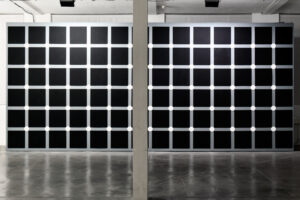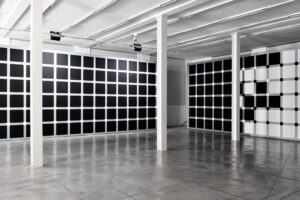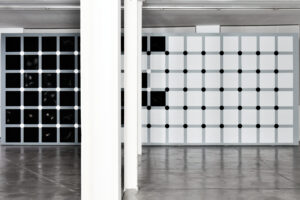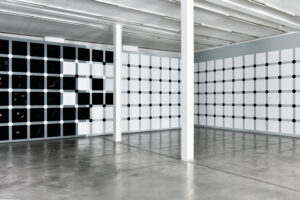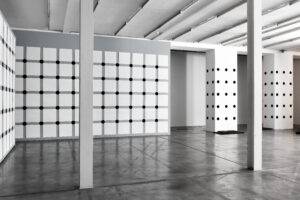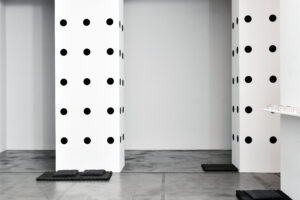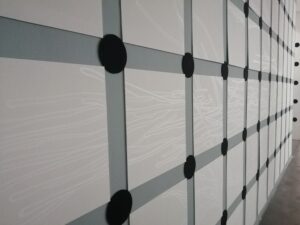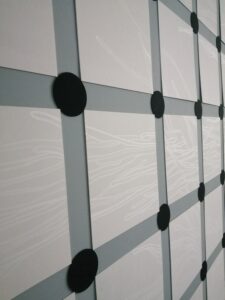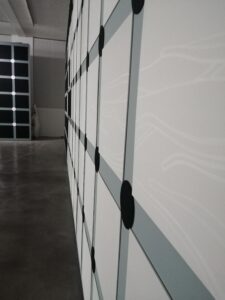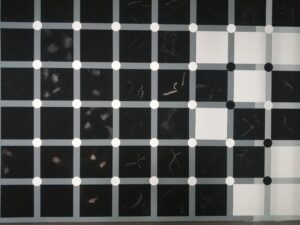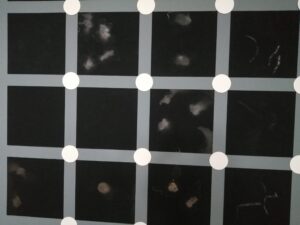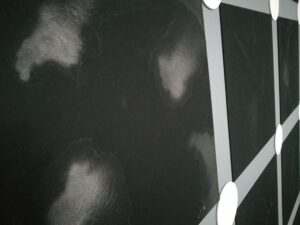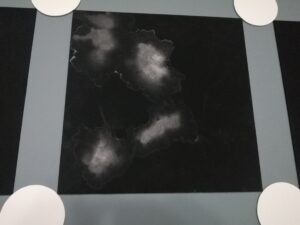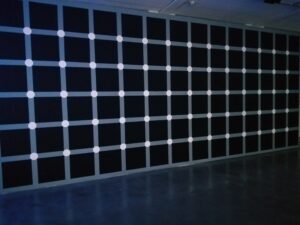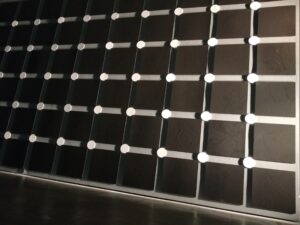Points de référence
Points de référence (Reference points) examines the notion of shared experience through aphantasia. It is an immersive space, the projection of a troubled mind for which reality is uncertain and changing.
Aphantasia is the inability to represent a mental image. We are all on the spectrum between aphantasia and hyperphantasia. It affects pictorial auditory and olfactory images and profoundly influences the way we think, remember and perceive the world. We design our reality based on these perceptions and memories. Our brain takes the oceans of information that flood our senses and transforms them into a subjective inner world that seems immutable. Over time, the memories that construct this reality change and become out of sync with those of others, even if they are common experiences.
When our worldview changes, we modify our memories to address cognitive dissonance. Furthermore, we tend to see and hear what we expect to see and hear, and everything leads us to believe that this is the reality, and even that this reality is shared by others. We don’t have the same reference points and we don’t have the same memories; it’s a miracle that we understand each other, if indeed we can be understood at all.
This installation plays with the limits of the visual system, so artists and spectators, although present at the same time, perceive very personal realities. Afterwards, as they compare them, they build a new composite and collective reality.
Artists :
Jonathan O’Hear and Carolina Restrepo
Exhibition
07 – 19 june 2022
Mo-Sa 4pm-7pm / Su 11am-4pm and on appointment
Flux laboratory
5, rue de la muse
1205 Genève
T +41 22 308 14 50
Contextualisation
(for the exhibition at Flux laboratory – Geneva)
(original french version below)
Projections of the mind’s eye. At the beginning of this project, I thought I would work on how we relate to shared experiences. In recent years, my projects had led me to understand that, biologically, we do not have the same perception of the physical world around us, that we are constantly modifying our memories to fit our current world view and that it is from this basis that we construct what we call reality.
“I was there…”. An experiment that used Photoshop to add people into photos of events they did not attend, saw them make up false memories related to those photos, possibly in response to the cognitive dissonance that it had caused. So we don’t even have the same memories as ourselves.
To begin the two months of creative residency at Flux Laboratory I explored optical illusions, but it was Professor Adam Zeman’s article1 which led me to aphantasia.
Aphantasia is the absence of mental images, sometimes visual, auditory or olfactory. Based on my readings and many informal discussions, we all fall on a spectrum between aphantasia and hyperphantasia. My surprise was not to discover that I am completely aphantastic but rather that others are not. “So you really see sheep jumping over a fence? Ah, I count in the dark”. Most people I talk to are also surprised to discover that others have mental representations that are so different to their own. Instinctively, we believe that we represent the world in a similar way to others. It’s absolutely fascinating to realise how different we are, how we don’t have the same perceptions or reference points and how our memories are constantly being rewritten. And yet, everything leads us to believe that we share the same reality with others. For me, it’s a miracle that we even understand each other, insofar that we can be understood at all. So, the project became denser but also more personal and I decided to represent my attempts to visualise mental images in the form of black on black on black acrylic paintings. The aim is to share the almost nothing that I see when I visualise with my inner eye, and to speak about the aphantasia-hyperphantasia spectrum.
Carolina Restrepo is the artist and friend who guided my learning of the necessary techniques to represent my aphantasia. We sought the most direct connection possible between my hand and my visualizations in order to translate the blurred images and furtive concepts that populate my imagination.
Carolina is hyperphantasic and has been doing a very subtle work of white on white for years.
Carolina : “My work is purely playful, I try to get away from my mental images as much as possible. By having fun recreating what I can’t visualize, I let my hands, pencils and brushes show me what’s beyond what I see and hear in my mind.
It’s funny to learn that we don’t all have the same ability to represent images in our minds, that not everyone hears their own voice when thinking, or sees an image for every word they hear.
In this work, white on white, there is a parallel reality of vibrations and emotions.
Perfect: between the two of us, we can create an experiential space that conveys how each person has their own understanding of the world.
In the space. Through the changes of light, there are white lines intertwining and disappearing, and the visualizations of my inner eye imagining the performances, the nothingness and the violent accident that happened to me just before I started to paint.
This hallucinatory installation is also an echo chamber for two of the four performances that took place there: Ripe and Monochromes intérieurs. Ripe is a performance that works on the effect of fatigue when a performer, Brice Catherin, exhausts himself dancing and then plays a virtuoso piece on the cello and starts again. Monochromes intérieurs is a performative installation that pushes the brain so far into the sonic and visual abstract that it can only hallucinate the concrete that allows it to make sense. Trances, hallucinations and perceptual disorders accompany the performers and spectators during these shared experiences. Finally, the hope of a project like this is that the discussions that follow will help us to try to understand the other from his or her point of view rather than from our own.
Jonathan, June 2022
1 https://psyche.co/ideas/when-the-mind-is-dark-making-art-is-a-thrilling-way-to-see
Contextualisation
(pour l’exposition à Flux laboratory – Genève)
Projections de l’œil intérieur. Au début de ce projet, je pensais travailler sur notre rapport à l’expérience commune. Ces dernières années, mes projets m’avaient amené à comprendre que nous n’avons, biologiquement, pas la même perception du monde physique qui nous entoure, que nous modifions constamment nos souvenirs pour qu’ils correspondent à notre vision du monde et que c’est à partir de cette base que nous construisons ce que nous appelons la réalité.
«J’y étais…». Une expérience qui utilise Photoshop pour ajouter des personnes dans des photos d’évènements auxquels elles n’ont pas assisté les voit créer de faux souvenirs liés à ces photos, possiblement en réaction à la dissonance cognitive qu’elles causent. Nous n’avons donc même pas les mêmes souvenirs que nous-mêmes.
Deux mois de résidence de création à Flux Laboratory me permettent de commencer ce travail en explorant les illusions d’optique. Mais c’est en lisant l’article du professeur Adam Zeman1 que j’en suis arrivé à l’aphantasie.
L’aphantasie est l’absence d’images mentales parfois visuelles, sonores ou olfactives. D’après mes lectures et de nombreuses discussions informelles, nous nous situons tous sur un spectre entre aphantasie et hyperphantasie. Ma surprise n’était pas de découvrir que je suis complètement aphantasique mais plutôt que les autres ne le sont pas. «Donc vous voyez vraiment des moutons qui sautent par-dessus une barrière ? Ah, moi, je compte dans le noir». La plupart des personnes avec qui je discute sont également surprises de découvrir que les autres ont des représentations mentales qui diffèrent autant des leurs. Instinctivement, nous pensons nous représenter le monde similairement aux autres. C’est absolument fascinant de se rendre compte à quel point nous différons, nous n’avons pas la même perception ni les mêmes points de référence et nos souvenirs sont en perpétuelle réécriture. Et pourtant, tout nous pousse à croire que nous partageons une même réalité avec les autres. De mon côté, je me dis que c’est un miracle qu’on se comprenne, pour autant qu’on puisse être compris.e. Ainsi, le projet devient plus dense mais aussi plus personnel et je décide de représenter mes tentatives d’images mentales sous forme de tableaux acryliques noir sur noir sur noir. L’envie est de partager le presque rien que je vois lorsque je visualise avec mon œil intérieur, et de parler du spectre aphantasie-hyperphantasie.
Carolina Restrepo est l’artiste et amie qui m’a guidé dans mon apprentissage des techniques pour représenter mon aphantasie. On cherche la connexion la plus directe possible entre ma main et mes visualisations pour traduire les images floues et les concepts furtifs qui peuplent mon imaginaire.
Carolina est hyperphantasique et fait un travail très fin de blanc sur blanc depuis des années.
Carolina : «Mon travail est purement ludique, je m’éloigne le plus possible des images mentales. En m’amusant à recréer ce que je ne peux pas visualiser, je laisse mes mains, les crayons et les pinceaux me raconter ce qu’il y a au-delà de ce que je vois et ce que j’entends dans mon mental.
C’est drôle d’apprendre que nous n’avons pas tous la même capacité de représenter des images dans nos têtes, que tout le monde n’arrive pas à entendre sa propre voix en réfléchissant, ou à voir une image pour chaque mot qu’on entend.
Dans ce travail, blanc sur blanc, se cache une réalité parallèle composée de vibrations et d’émotions.»
C’est parfait : à nous deux, nous pouvons créer l’espace expérientiel qui raconte à quel point chacun·e a une compréhension du monde qui lui est propre.
Dans l’espace. A travers les changements de lumière, on peut voir des lignes blanches s’entremêler et disparaître, et les visualisations de mon œil intérieur en imaginant les performances, le néant et le violent accident qui m’est arrivé juste avant de commencer à peindre.
Cette installation hallucinatoire est aussi une chambre d’écho pour deux des quatre performances qui s’y produisent : Ripe et Monochromes intérieurs. Ripe est une performance qui travaille sur l’effet de la fatigue lorsqu’un performeur, Brice Catherin, s’épuise à danser puis joue une pièce de virtuose au violoncelle et recommence. Monochromes intérieurs est une installation performative qui pousse les cerveaux si loin dans l’abstrait sonore et visuel qu’il ne peut qu’halluciner le concret qui lui permet d’y donner un sens. Transes, hallucinations, troubles de la perception accompagnent ainsi les performeurs et les spectateur·ices lors de ces expériences communes. Finalement l’espoir d’un projet comme celui-ci est que les discussions qui s’en suivent nous aident à chercher à comprendre l’autre depuis son point de vue plutôt que depuis le nôtre.
Jonathan, juin 2022
1 https://psyche.co/ideas/when-the-mind-is-dark-making-art-is-a-thrilling-way-to-see
